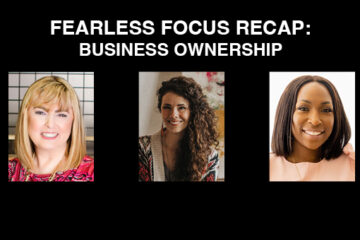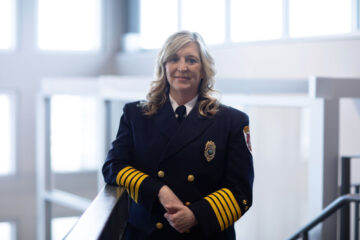By Emily Kestel
Women Lead Change held its annual Central Iowa Conference last month, and like last year, I’m once again happy to summarize my 11 pages of notes in hopes that you’ll find something useful or inspiring to tuck in your pocket or refer to for future use.
Below are seven takeaways from various keynotes and breakout sessions I attended.
Prioritize having fun
Science journalist Catherine Price was blunt when she said, “We need to have fun, and we aren’t taking fun seriously,” during her keynote address.
“Fun is the secret to feeling alive,” she said. “Fun boosts resilience and reduces burnout. Fun builds trust. Fun makes us creative, healthier and happier.”
True fun often happens through playfulness, where you have a lighthearted attitude and let go of perfectionism; connection, where you share an experience with someone; and flow, a psychological state where you lose track of time, she explained.
Dubbing it a “funtervention,” Price explained steps to having a more joyful, fun life through the acronym SPARK.
The S is for making space, in which you reclaim your time and give yourself permission to prioritize your own fun.
P is for pursuing passions, where you do things that you enjoy and explore new hobbies or interests.
A is for attracting fun, which includes identifying “fun magnets” and adopting a fun mindset.
R stands for rebel – though playfully.
K stands for keeping at it, which can be done by creating “booster shots” of always having something to look forward to, and seeking new opportunities to create playful, connected flow.
She also said one of her habits is saying the word “delight” out loud every time she sees or experiences something that sparks joy.
Build confidence with a growth mindset
In her keynote speech, author Nada Lena Nasserdeen laid out 15 challenges that female leaders face, and argued that many of them are related to confidence. Challenges she mentioned included: a lack of support from other women, speaking up, building alliances, asking for money, reentering the workforce after becoming a parent, overcoming perfectionism and tackling imposter syndrome.
Lack of self-confidence and “wasted human potential” are “the greatest tragedy we see today,” Nasserdeen said.
She encouraged attendees to work on building “macroconfidence” instead of “microconfidence.”
Macroconfidence, she said, is where you believe that you are enough simply because you exist, and you maintain a growth mindset. Microconfidence is when you have confidence in specific areas of your life, such as your career, relationships, speaking up, instead of a more holistic approach.
With a growth mindset, she said, you shift your frame of thinking from “I can’t” or “I don’t know” to “I can’t yet.”
Nasserdeen gave several pieces of advice on building confidence, which included:
- Practice failing.
- Embrace new opportunities.
- Don’t focus on what you don’t know; think about the value you bring to the table.
- Forget perfection.
- Remember that you are enough, and no one can convince you of that except you.
There is beauty in the cracks
In her keynote address, executive coach Dima Ghawi shared the story of her family’s commitment to maintaining an unblemished reputation.
“I came from a part of the world where I was taught, at an early age, to be follower, quiet and subservient. I was fiercely constrained by the Middle Eastern culture, community and family expectations that molded me to be absent of identity,” Ghawi said.
When she made the decision to divorce her husband after moving to the U.S., her father turned on her and threatened to kill her for damaging “the honor of my family’s reputation.”
Throughout her story, she used the metaphor of a glass vase to represent the unrealistic expectations placed upon her and others.
“We all live with vases,” she said. “They inhibit us from living the life we deserve.”
She encouraged attendees to examine all of the vases, or barriers, that are holding them back, and “smash them into a million pieces.”
Ghawi also brought up the Japanese art of kintsugi, or “golden seams.” The technique involves repairing broken pottery by using glue and gold pigment to put it back together.
“There is beauty in the cracks,” she said. Reject the idea of being perfect, she added.
The magic happens in inclusion
Kate Hightshoe-Lambert, diversity officer at QCR Holdings, spoke in a breakout session about the importance of diversity, equity and inclusion at workplaces.
“Diversity of all kinds makes our companies and communities better and stronger,” she said. “DEI is a trend that’s here to stay.”
She warned against getting “too fancy” with DEI work, and said she sees it being built on a house of cards, where there’s no foundation.
She said a key foundational principle to DEI is remembering that diversity is everyone, not just people of color, women and LGBTQ people.
“We don’t get to pick and choose whose differences get to come first,” Hightshoe-Lambert said. “Anything but ‘everyone is diverse’ is not inclusion.
“If people don’t see themselves as diverse, they won’t want to be part of the solution, and it will be nothing but checking the box, which doesn’t add value.”
She said the magic of DEI happens through inclusion.
“When we bring our most authentic selves to the table, when we realize that inclusion starts with I, we can then experience that magic.”
To promote civility, identify a common goal
Retired U.S. Ambassador Mary Kramer opened her breakout session about civility in the public discourse by asking, “How did we get so rude?”
“Our culture has accepted two huge lies,” she said. “Both are nonsense, and it’s causing fractures.” Those are “If you disagree with someone and their lifestyle, you must fear or hate them” and “To love someone, you must agree with everything they say and do.”
Kramer outlined contributing factors to those ideals, which included:
- Living wherever we want. “We choose our neighborhoods, churches, schools and news sources according to our world view. … This makes it harder to find common ground with people.”
- The 24-hour news cycle that thrives on spectacle and conflict. “There’s a lack of dialogue and problem-solving,” she said. “We become more entrenched in the platforms and news outlets that we seek out.”
It’s important to “look at the humanity of our opponents,” she said.
Kramer said when working or talking with people who have different opinions or beliefs, it’s important to come to the table asking, “What problem are we trying to solve?” and to find commonalities rather than focusing on differing views.
Invite people to the table when leading through change
Local business leaders Emily Berrier, associate vice president of farm underwriting and sales at Nationwide; Megan Bohenkamp, human resources manager at IMT Insurance; Jennifer Bryant, owner of Human Pivot; and Kristin Tague, senior talent development partner at American Equity, held a breakout discussion about leading through change.
Change is inevitable, the panelists said. It can be scary but it doesn’t have to be, and it helps to be adaptable.
We all have three levers that we can pull at will, Bryant said. Those are: asking a question, changing your lens or perspective, and inviting someone in.
“A lot of times, we think about the process, but we need to remember the people,” Bohenkamp said. Focus on “communication, collaboration and commitment.” If you want to lead through change successfully, put an emphasis on good communication and allow your team to ask questions throughout the process, she said.
“Meet people where they are,” Berrier said. “Not everyone goes through change the same way, and you end up making better decisions when you invite people to the table.”
Look at setting boundaries as if they were a hula hoop
Speaker Courtney Misener in her keynote talked about how to set boundaries and recognize what’s beyond your control. Throughout her remarks, she used the metaphor of a hula hoop to describe the realm of control.
“Boundaries outline where you end and where the world begins. They are the clear limits that separate us from others. This requires activating the hula hoop,” Misener said.
Inside your hula hoop is what’s in your control, including your behavior, your ideas, the way you treat and help others, who you surround yourself with, what you choose to read and watch, and how you take care of yourself.
Outside of your hula hoop is what’s out of your control, including the weather, someone else’s beliefs and opinions, how someone responds, someone else’s decisions, past mistakes, and what others post on social media.
“We spend so much time on what’s outside of our control that we miss opportunities for joy,” Misener said.
Emotional boundaries include separating our own feelings from others’ feelings, she said.
“You can’t control other people’s feelings,” she said. When you put up a boundary or tell someone no, remember that someone else’s disappointment or anger doesn’t make you a bad person.
“My ‘no’ might make you sad, but it doesn’t make me bad,” Misener said.
Other one-liners
Always think to yourself, “What’s the worst that’ll happen? … Trust the process.” – Joanna Teplin
“Recognize your power of being an informal leader.” – Emily Berrier
“Sometimes it’s better to be kind than to be right.” – Jennifer Bryant
“Knowledge is light, and ignorance is darkness.” – Dima Ghawi
“We are better together. When we link arms, when we are vulnerable, when we huddle, that’s when we are successful.” – Brooke Baldwin
“Don’t be a content consumer, be a content activator. Knowledge without action is nothing.” – Nada Lena Nasserdeen


